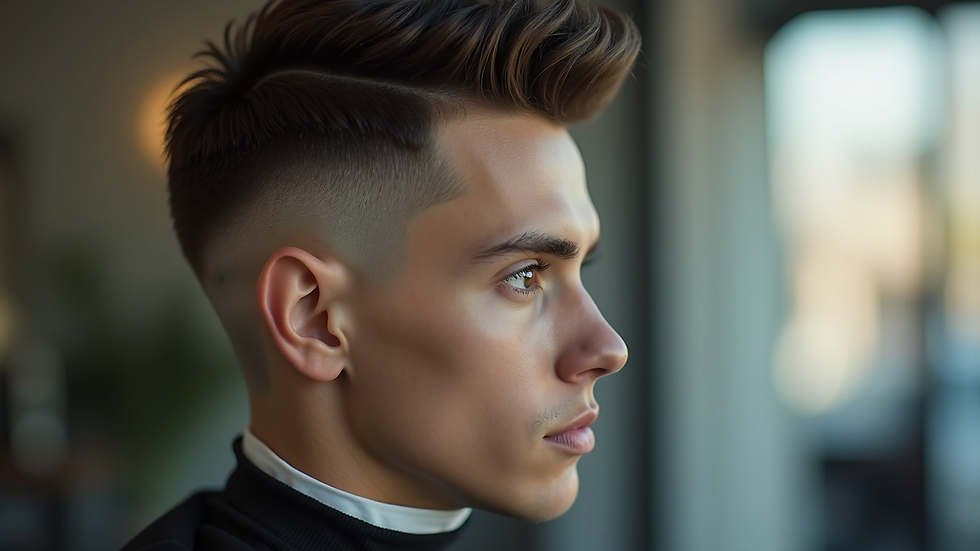- Manny The Barber

- May 12
- 4 min read
In recent years, classic barbershops have experienced a revival that many didn’t anticipate. Old-fashioned establishments, complete with leather chairs and skilled barbers, are becoming increasingly popular among a wide range of clientele. This shift reveals more than just a trend; it reflects a deeper longing for community, tradition, and personalized service.

The Appeal of Classic Barbershops
There’s something distinctly appealing about classic barbershops. For many, these spaces offer an escape from the fast pace of modern life. Quality service is at the forefront. Barbers take time to engage with their customers, making each visit feel personal and special.
A recent survey found that 70% of customers prefer a barbershop where they can form a relationship with the barber over simply getting a quick haircut. This reflects a trend toward valuing experience over convenience.
Furthermore, the interior of a classic barbershop creates an atmosphere that is both nostalgic and comforting. Often adorned with vintage posters, leather seats, and retro tools, these spaces transport you to a time when life seemed simpler.

Classic Barbershops
Classic barbershops aren't just about haircuts; they often provide a variety of grooming services that evoke a sense of an era gone by. From traditional haircuts to hot towel shaves, the services are designed to pamper and elevate one's grooming routine.
Many barbershops are also introducing contemporary styles while keeping to classic techniques. Barbers blend modern trends with traditional craftsmanship, ensuring that customers receive exactly what they envision. People are often willing to pay extra for the additional services provided in a classic setting because of the quality and atmosphere they offer.
Besides grooming, barbershops host an array of community events, such as “Barber Battles” and charity fundraisers, reinforcing the communal spirit. This adds layers to the experience that you won't find in standard hair salons.
What is a Traditional Barbershop?
A traditional barbershop is characterized by its timeless practices and focus on male grooming. These establishments typically offer services specifically designed for men's hair and facial care.
Services can include:
Haircuts with classic techniques such as scissor cuts and fades.
Beard grooming, including trims and hot towel shaves.
Specialized treatments like scalp massages and hair styling.
Traditional barbers prioritize maintaining relationships with their clients. This type of personalized service often includes in-depth consultations where barbers understand customer preferences and styles over time.
Building Community
One of the significant reasons for the resurgence of classic barbershops is their role as community hubs. In an increasingly digital world, people crave genuine human interaction.
Barbershops often become spaces where patrons share stories or catch up on local news. This community-building aspect fosters loyalty among customers. For men especially, these shops often serve as gathering spots, much like a local pub.
A unique study shows that 60% of individuals feel more connected to their community when they regularly visit their barber. The barbershop experience extends beyond a haircut; it creates opportunities for social engagement and connection within the local community.

Men’s Grooming Culture
The return of classic barbershops also coincides with the increasing importance of men’s grooming culture. There is a rising acknowledgement among men that grooming reflects personal style and confidence.
According to market research, the men’s grooming market is projected to exceed $166 billion by 2022. This burgeoning growth highlights a shift as men begin seeking quality over quantity in their grooming services. Barbershops are becoming focal points for those interested in learning about proper grooming techniques and trends.
Social media plays a significant role as well. Platforms like Instagram offer a window into stylish cuts and grooming techniques, leading men to seek out skilled barbers who can recreate trending styles. The return to classic barbershops offers individuals opportunities to engage with knowledgeable barbers who understand both modern and traditional styles.
More Than Just a Haircut
Visiting a classic barbershop is about more than just getting a haircut; it's about experiencing a timeless tradition. It’s about the overall experience that accompanies it. Many barbers now provide a range of services that transform the simple haircut into a full grooming experience.
From classic shaves that utilize precision razors to inviting shampoos and scalp massages, each step is designed to make you feel pampered.
For an authentic experience, consider visiting establishments providing good old fashioned barbershop services. A straight razor shave can deliver an experience to remember, setting it apart from contemporary offerings.
Emerging Trends in the Barbershop Industry
How have barbershops adapted to modern lifestyle changes? Many classic barbershops have embraced technology while maintaining traditional elements. Online booking systems, loyalty programs, and social media marketing tools are now common.
While some barbershops still promote walk-in services, the implementation of online scheduling helps meet the demands of today’s busy customers. Furthermore, social media marketing allows barbershops to showcase their talent and engage with a younger audience, thus appealing to a broader demographic.
Moreover, eco-friendly practices are becoming a norm in some establishments. Sustainable products and energy-efficient tools contribute to an eco-conscious image, attracting environmentally aware customers.
Lasting Legacy
The comeback of classic barbershops reveals a societal shift towards valuing craftsmanship and personal interaction. As people increasingly seek meaningful experiences, these establishments rise to meet those needs.
The quintessential barbershop evolves but remains anchored in its traditions. It creates community, fosters relationships, and offers quality grooming services that are hard to match.
Whether you're looking for a straightforward haircut or a lavish grooming experience, classic barbershops provide both. With their roots deeply embedded in tradition and culture, they are demonstrating that timeless practices can thrive alongside modern trends.
By understanding the fundamental appeal of classic barbershops, we see that they are here to stay. The resurgence in interest signifies a longing for connections and authenticity in our grooming routines. Experience this revival first-hand, and visit a classic barbershop near you today!






